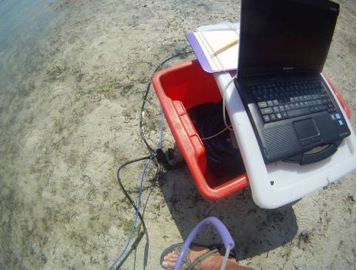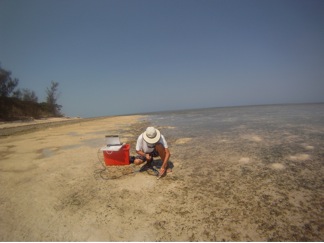22nd May is International Day for Biodiversity and the theme for 2012 is Marine Biodiversity. In celebration, we will be featuring a series of articles on seagrass. This week, Michael Durako writes about his experiences visiting North Queensland, Australia.
———————————————————-
Photos and text by Michael J. Durako
During the Fall 2011 semester while on research reassignment from my University, I spent 5 weeks with the Marine Ecology Group (MEG), Fisheries Queensland in Cairns hosted by Dr. Robert Coles, Dr. Michael Rasheed and my former student Katie Chartrand. During this research visit I focused on assessing changes in leaf spectral reflectance as an indication of seagrass physiological condition, specifically in response to light and desiccation stress. During my visit I was able to sample two relatively pristine sites on Green Island, which is 24 km offshore of Cairns, and several highly-impacted sites in Gladstone Harbour, which is 250 km north of Brisbane. Before departing for Cairns I was able to assemble a field compatible spectral reflectance system to obtain spectral reflectance measurements in situ using, with the help of Randy Turner and Lance Horn at the University of North Carolina Wilmington Center for Marine Science. The system consisted of a 25m long optical fiber reflectance probe connected through a variable neutral density filter to an Ocean Optics spectrometer with data acquisition controlled by OOI Spectra Suite software via a waterproof external switch and a Panasonic Toughbook PC.
 Figure 1. Ocean Optics reflectance setup at Green Island.
Figure 1. Ocean Optics reflectance setup at Green Island.
After calibration and testing the reflectance measurement system at the Northern Fisheries Center in Cairns, I set up a short-term shading experiment on Green Island. Shades, which reduced irradiance by 70%, were placed over Halophila ovalis (Hov) and Thalassia hemprichii (Th) located along the inner fringe of a seagrass bed on the south side of the island. The spectral reflectance of leaves of these two species were compared between adjacent full-sun and shaded plots from 0800 to 1400h to determine if this bio-optical characteristic exhibited short-term diurnal changes in high and low light treatments. The resulting reflectance spectra showed significant species, time and treatment differences.
 Figure 2. Shade plots over Halophila ovalis and Thalassia hemprichii at Green Island.
Figure 2. Shade plots over Halophila ovalis and Thalassia hemprichii at Green Island.
During my visit, I was very fortunate to be able to participate in an aerial (helicopter) seagrass survey trip to Mourilyan Harbor, 80 km south of Cairns. Because of the high tidal range (4 m), turbid water and presence of saltwater crocodiles, aerial survey techniques are broadly used by MEG in their seagrass assessment work in northern Queensland. This aerial approach may be applicable and more efficient for some of our FHAP sampling sites in Florida Bay. We were able to sample 126 sites in about 2 hours and never got our feet wet!
 Figure 3. Hovering (altitude 1m) at a seagrass sampling site in Mourilyan Harbor. Helen Taylor of MEG is entering the GPS location of the sampling station on an ARC GIS map using a touchscreen PC. Carissa Fairweather is communicating sampling information to the pilot. My job was to enter the seagrass data on the field datasheets.
Figure 3. Hovering (altitude 1m) at a seagrass sampling site in Mourilyan Harbor. Helen Taylor of MEG is entering the GPS location of the sampling station on an ARC GIS map using a touchscreen PC. Carissa Fairweather is communicating sampling information to the pilot. My job was to enter the seagrass data on the field datasheets.
I visited Gladstone Harbor over Sept 27-29th as part of a compliance sampling trip for Queensland Fisheries. During this trip I compared the spectral reflectance of submerged versus exposed seagrasses at four sampling sites: Pelican North, Whiggins, Fisherman’s Island and Pelican South. Because of the large tidal range (3-4m) and high turbidity, we could only sample during the afternoon low tides. Reflectance data indicated distinct spectra between submerged and exposed leaves for both Zostera capricorni and Halophila ovalis at all four sites (see example spectra in Fig. 6; note separation of spectra from 500-680nm).
 Figure 4. Launching the Fisheries Queensland R/V Halophila at Gladstone Harbor.
Figure 4. Launching the Fisheries Queensland R/V Halophila at Gladstone Harbor.
 Figure 5. Sampling exposed Zostera capricorni at Pelican South, Gladstone Harbor.
Figure 5. Sampling exposed Zostera capricorni at Pelican South, Gladstone Harbor.
 Figure 6. Normalized reflectance of submerged (wet) versus exposed (Dry) Zostera capricorni at North Pelican, Gladstone Harbor.
Figure 6. Normalized reflectance of submerged (wet) versus exposed (Dry) Zostera capricorni at North Pelican, Gladstone Harbor.
Near the end of my visit, I was able to visit Green Island again. My plan was to repeat the shading study in another location on the Island. However, because of an early occurrence of Irukandji jellyfish, which are extremely venomous, the island was closed to swimming, within an hour of my arrival on the island. One of the resort divers was stung on the lip (she had on a stinger suit) and had to be MediVaced off the island by helicopter. Thus, I had to limit my sampling to only low tide. To make lemonade from lemons, I revised my sampling to be similar to what I had done in Gladstone Harbor. I compared the spectral reflectance of submerged and exposed Thalassia hemprichii and Halophila ovalis. The reflectance spectra were again distinct between species and between submersed and emersed shoots, although the differences were more subtle than those at Gladstone. The results from this short field visit suggest that spectral reflectance provides a rapid assessment method that is sensitive to changes in seagrass physiological condition and it provides another tool in our arsenal of non-invasive physiological ecoindicators.
 Figure 7. Measuring spectral reflectance of exposed Halophila ovalis at Green Island.
Figure 7. Measuring spectral reflectance of exposed Halophila ovalis at Green Island.